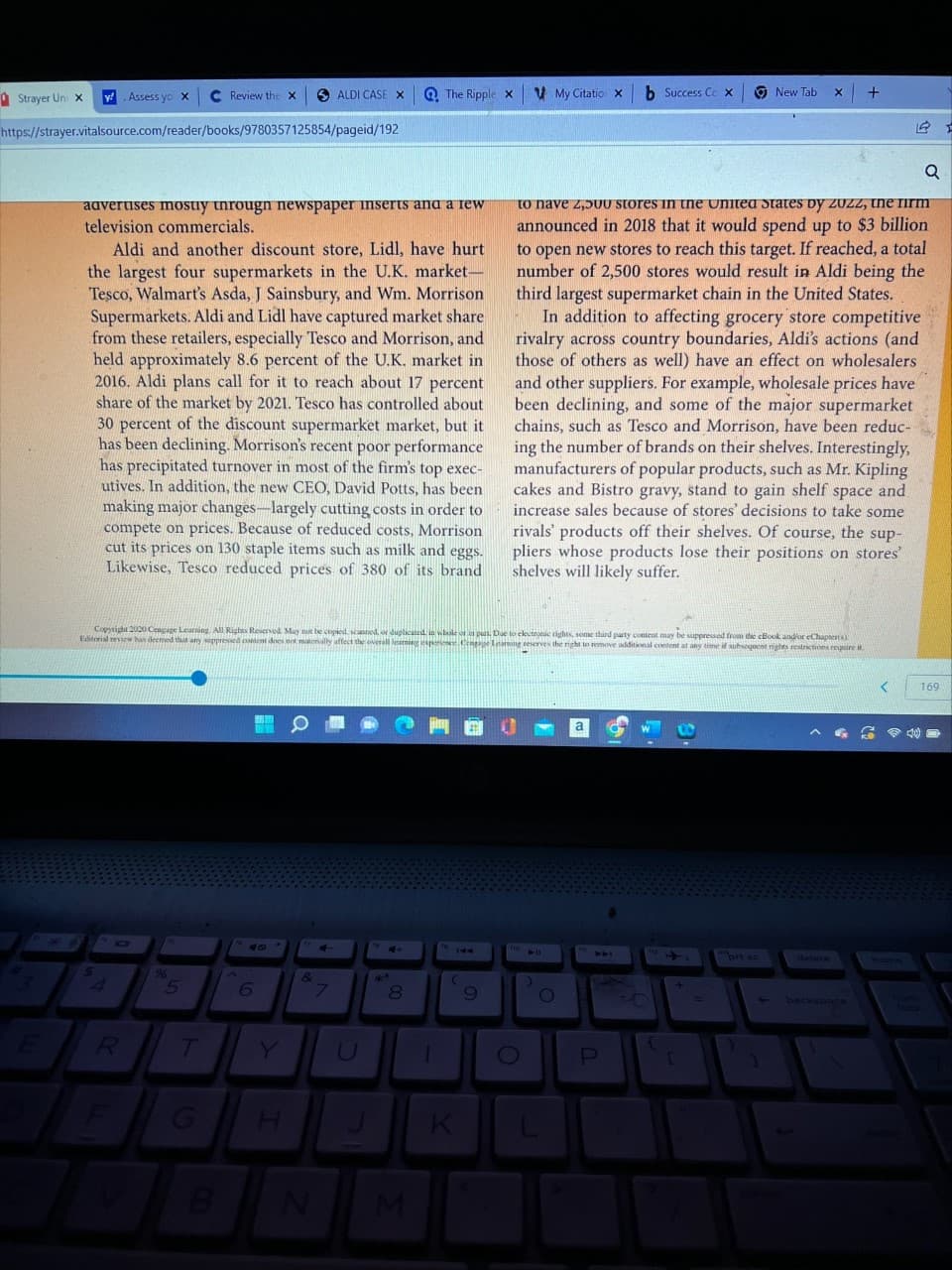Review the Aldi case study on page 169 of your textbook. Assess your satisfaction with Aldi and make recommendations about how the company could modify its business-level strategy to both increase your overall level of satisfaction and to attract new customers. Provide specific examples to support your response. Analyze the five business-level strategies discussed in Chapter 4 to determine which strategy ( cost leadership, differentiation, focused cost leader-ship, focused differentiation, and integrated cost leadership/differentiation) most likely applies to Aldi. Determine how a shopper's experience might change if it switched to one of the other four strategies (your choice). Explain your rationale.
Review the Aldi case study on page 169 of your textbook. Assess your satisfaction with Aldi and make recommendations about how the company could modify its business-level strategy to both increase your overall level of satisfaction and to attract new customers. Provide specific examples to support your response. Analyze the five business-level strategies discussed in Chapter 4 to determine which strategy ( cost leadership, differentiation, focused cost leader-ship, focused differentiation, and integrated cost leadership/differentiation) most likely applies to Aldi. Determine how a shopper's experience might change if it switched to one of the other four strategies (your choice). Explain your rationale.
Principles Of Marketing
17th Edition
ISBN:9780134492513
Author:Kotler, Philip, Armstrong, Gary (gary M.)
Publisher:Kotler, Philip, Armstrong, Gary (gary M.)
Chapter1: Marketing: Creating Customer Value And Engagement
Section: Chapter Questions
Problem 1.1DQ
Related questions
Question
- Review the Aldi case study on page 169 of your textbook. Assess your satisfaction with Aldi and make recommendations about how the company could modify its business-level strategy to both increase your overall level of satisfaction and to attract new customers. Provide specific examples to support your response.
- Analyze the five business-level strategies discussed in Chapter 4 to determine which strategy ( cost leadership, differentiation, focused cost leader-ship, focused differentiation, and integrated cost leadership/differentiation) most likely applies to Aldi. Determine how a shopper's experience might change if it switched to one of the other four strategies (your choice). Explain your rationale.

Transcribed Image Text:Strayer Uni x
C Review the X
v. Assess yo X
https://strayer.vitalsource.com/reader/books/9780357125854/pageid/192
advertises mostly througn newspaper inserts and a rew
television commercials.
$
Aldi and another discount store, Lidl, have hurt
the largest four supermarkets in the U.K. market-
Tesco, Walmart's Asda, J Sainsbury, and Wm. Morrison
Supermarkets. Aldi and Lidl have captured market share
from these retailers, especially Tesco and Morrison, and
held approximately 8.6 percent of the U.K. market in
2016. Aldi plans call for it to reach about 17 percent
share of the market by 2021. Tesco has controlled about
30 percent of the discount supermarket market, but it
has been declining. Morrison's recent poor performance
has precipitated turnover in most of the firm's top exec-
utives. In addition, the new CEO, David Potts, has been
making major changes-largely cutting costs in order to
compete on prices. Because of reduced costs, Morrison
cut its prices on 130 staple items such as milk and eggs.
Likewise, Tesco reduced prices of 380 of its brand
R
%
5
SALDI CASE X
T
Copyright 2020 Cengage Learning. All Rights Reserved. May not be copied, scanned, or duplicated, in whole or in pas. Due to electronic rights, some third party content may be suppressed from the cBook and/or eChapter(s)
Editorial review has deemed that any suppressed content does not materially affect the overall leaming experience Cengage Learning reserves the right to remove additional content at any time if subsequent rights restrictions require it.
G
B
6
&
4
7
C
4+
QThe Ripple X
**
00
M
1
K
9
O
My Citatio x b Success Cc x
to have 2,500 stores in the United States by Zuzz, the firm
announced in 2018 that it would spend up to $3 billion
to open new stores to reach this target. If reached, a total
number of 2,500 stores would result in Aldi being the
third largest supermarket chain in the United States.
In addition to affecting grocery store competitive
rivalry across country boundaries, Aldi's actions (and
those of others as well) have an effect on wholesalers
and other suppliers. For example, wholesale prices have
been declining, and some of the major supermarket
chains, such as Tesco and Morrison, have been reduc-
ing the number of brands on their shelves. Interestingly,
manufacturers of popular products, such as Mr. Kipling
cakes and Bistro gravy, stand to gain shelf space and
increase sales because of stores' decisions to take some
rivals' products off their shelves. Of course, the sup-
pliers whose products lose their positions on stores'
shelves will likely suffer.
IN
411
)
O
a
THE
P
{
[
New Tab X
=
prt sc
+
}
<
home
Q
Pum
169

Transcribed Image Text:<
E
Week 3- X
← C https://strayer.vitalsource.com/reader/books/9780357125854/pageid/192
N
89°F
Clear
Strayer Un x
S
3
ME
v. Assess yo x
E
$
Aldi started as a small, family-owned grocery store
located in Essen, Germany, in 1913. Two sons, Karl and
Theo, took over the store from their mother in 1946;
soon after doing so, they began expanding the business.
They emphasized low costs from the very beginning,
allowing them to offer their products to customers
at low prices relative to competitors. Over time, Aldi
expanded to other European countries, and it entered
the United States market in 1976. Currently, there are
roughly 11,000 Aldi stores located in 20 countries; 1,750
of these units are in 35 states in the United States. In the
United States alone, the firm serves 40 million custom-
ers on a monthly basis.
Aldi holds its costs down in a variety of ways. It
largely sells its own brand-label products in "no frill"
stores. The company limits the number of external
brands it sells (usually one or two per product), and it
has low packaging, transportation, and employee costs.
To sell products in its stores, Aldi positions them in
ways that are similar to the approach warehouse stores.
4
R
C Review the X SALDI CASE X
96
5
T
G
B
40
6
O
H
&
4
7
N
G
U
14+
24*
J
8
The Ripple X
M
P
1
(
K
9
My Citatio X b Success Cox
W11
L
products by about 25 percent. Yet, because of gains in
its market share, Aldi plans to invest about $900 million
to open 550 new stores in Britain by 2022.
Aldi is having similar effects on the Australian
market. It has gained market share from the two largest
supermarkets in Australia-Coles and Woolworths. In
response, Woolworths indicated that it plans to reduce
its prices to avoid a perception among customers as the
"expensive option." This action does not seem to con-
cern Aldi in that the firm intends to spend $700 million
to add 120-130 stores by 2020 to its current number of
300 stores in Australia.
Aldi appears to be harming some competitors in
the United States as well. For example, a rival discount
food retailer, Bottom Dollar owned by Delhaize from
Belgium, closed all of its stores (located in New Jersey,
Pennsylvania, and Ohio) and sold the locations and
leases to Aldi. Aldi does have stiffer competition in the
United States from Walmart, Sam's (Walmart's ware-
house stores), and Costco, among other discount food
O
a
W
P
t
1
New Tab
C
Y
x +
4
detene
Q
<
40
169
Ther
Expert Solution
This question has been solved!
Explore an expertly crafted, step-by-step solution for a thorough understanding of key concepts.
This is a popular solution!
Trending now
This is a popular solution!
Step by step
Solved in 3 steps

Recommended textbooks for you

Principles Of Marketing
Marketing
ISBN:
9780134492513
Author:
Kotler, Philip, Armstrong, Gary (gary M.)
Publisher:
Pearson Higher Education,

Marketing
Marketing
ISBN:
9781259924040
Author:
Roger A. Kerin, Steven W. Hartley
Publisher:
McGraw-Hill Education

Foundations of Business (MindTap Course List)
Marketing
ISBN:
9781337386920
Author:
William M. Pride, Robert J. Hughes, Jack R. Kapoor
Publisher:
Cengage Learning

Principles Of Marketing
Marketing
ISBN:
9780134492513
Author:
Kotler, Philip, Armstrong, Gary (gary M.)
Publisher:
Pearson Higher Education,

Marketing
Marketing
ISBN:
9781259924040
Author:
Roger A. Kerin, Steven W. Hartley
Publisher:
McGraw-Hill Education

Foundations of Business (MindTap Course List)
Marketing
ISBN:
9781337386920
Author:
William M. Pride, Robert J. Hughes, Jack R. Kapoor
Publisher:
Cengage Learning

Marketing: An Introduction (13th Edition)
Marketing
ISBN:
9780134149530
Author:
Gary Armstrong, Philip Kotler
Publisher:
PEARSON


Contemporary Marketing
Marketing
ISBN:
9780357033777
Author:
Louis E. Boone, David L. Kurtz
Publisher:
Cengage Learning